
© Dancing Camera. (Click image for larger version)
Works & Process under Covid lockdown at the Guggenheim Museum, Lincoln Center, Kaatsbaan Cultural Park, Petronio Residency Center and Pillow Lab
including works by Ephrat Asherie, Omari Wiles, and Jamar Roberts among many others
New York, Guggenheim Museum and elsewhere
www.guggenheim.org
Works & Process, a series that has been running at the Guggenheim Museum for over thirty-five years, is a valuable part of New York City’s cultural life. The audience descends into the basement of the Frank Lloyd Wright-designed building and into a unique and beautiful little theater, rounded like the museum, where creators and performers present work and discuss it. Dance is frequently featured. While the content varies – a presentation, The Choreography of Light, featuring lighting designs by Brandon Stirling Baker and brief dances by Justin Peck and Jamar Roberts under varying lighting patterns was an unusual one in 2019 – many events preview upcoming work. There’s always conversation, but also, usually, plenty of performance. And afterward there are hors d’oeuvres or snacks and wine and seltzer offered upstairs in the Rotunda.
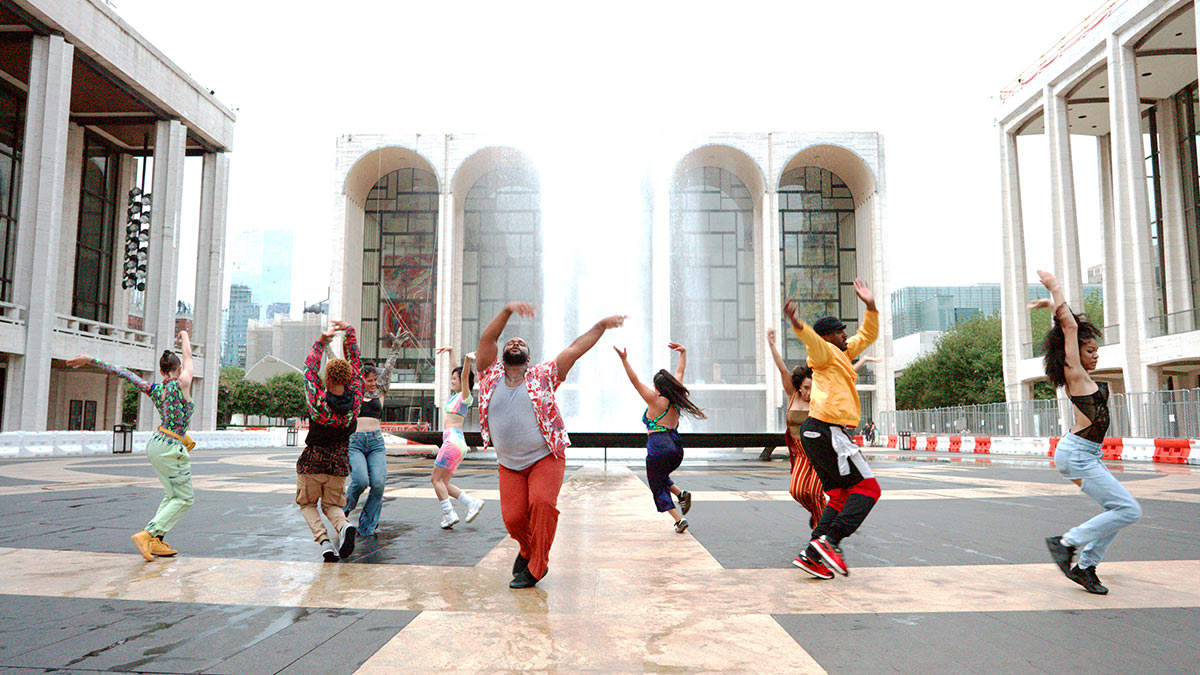
© Dancing Camera. (Click image for larger version)
During the Covid-19 pandemic Works & Process has been just as busy. Over one hundred short videos by an array of performing artists who made them themselves were commissioned. Lincoln Center joined Works & Process to present four short videos with larger forces, professionally videoed at the Lincoln Center campus. They are The Missing Element with The Beatbox House led by Chris Celiz and The Missing Element b-boys and other hiphop stylists led by Anthony Rodriguez “Invertebrate”; Music from the Sole with tap by Leonardo Sandoval and Gisele Silva and music led by Gregory Richardson; UnderScored by Ephrat Asherie Dance; and New York is Burning featuring Les Ballet Afrik with Omari Wiles. These lively videos against Lincoln Center backdrops are fun to watch.
Works & Process at Lincoln Center · Lincoln Center at Home
All of the participants in these videos plus a couple of other groups (choreographer Jamar Roberts with four fellow members of Alvin Ailey American Dance Theater; the beginnings of an interpretation of Kurt Weill and Bertolt Brecht’s Seven Deadly Sins led by Marc Happel with dancer Sara Mearns, choreographer Joshua Bergasse, and singing by Justin Vivian Bond) were part of bubble pods of creators that Works & Process sponsored at sites upstate in New York’s Hudson Valley. Some of these teams presented live performances at the Kaatsbaan Cultural Park, home of most of these bubbles, in the summer of 2020.
https://allarts.org/programs/isolation-to-creation/showtime-3qs50o/
The projects that were worked on upstate will be part of a Works & Process season at some later point when it is deemed ready to invite audiences back. But to give an idea of the creative process that went on in the pods, Works & Process presented four videos on ALL ARTS (allarts.org) on four Wednesdays, from January 27 to February 17. They are still available. I’ve been following three of the choreographers that were in the bubbles that are part of this series, Ephrat Asherie, Omari Wiles, and Jamar Roberts, so I was particularly interested in what they were doing last summer.
At Works & Process in January 2020 I much enjoyed parts of the pieces Asherie and Wiles were working on with their companies and saw more of this in the videos about the bubbles. Omari Wiles’ mother Marie Basse Wiles is a renowned Senegalese dance teacher in New York. His father, the late Olukose Wiles, was a notable drummer. Their company Mamouna Keita included their children. So Wiles has Senegalese dance as a birthright, to which he added all the African American vernacular forms of a New York childhood. Later he joined a ballroom house (now he has his own) and became a voguer. All this combines richly in his choreography, and his diverse dancers, many of them women, add their own nuances. His W&P piece, New York is Burning, emphasizes vogueing, but all the other elements are in the combination.

© Robert Altman. (Click image for larger version)
Ephrat Asherie, whose company Wiles has danced in, also combines many African American vernacular forms, including breaking, hiphop, house, vogueing, and swing. Her W&P piece, UnderScored, celebrates her love of club dancing, particularly saluting the Paradise Garage, and along with her company features two older dancers, Archie Burnett and Michele Saunders, who made their names as club dancers. At Works & Process the audience got a chance to dance along, making the elegant auditorium into a bit of a sober, but happy club.
Showtime | Isolation to Creation | ALL ARTS
Brief glimpses of the above presentations are in the first video, Isolation to Creation: A Way Forward, which introduces the participants, the pandemic and the testing, the Guggenheim itself, the people at the Guggenheim propelling this, Kaatsbaan and the Petronio Residency Center with their beautiful grounds and views of the Catskills, the bus bringing the bubbles upstate, and a little rehearsing. This is in short takes, although some are wordy, with quick cuts, and the cluttered result makes it a perhaps necessary and useful introduction, but the least absorbing of the videos, all just under half an hour.

© Dancing Camera. (Click image for larger version)
The next two videos are more engaging and revealing since they concentrate on the bubbles themselves. Each includes three of the bubble groups. The first, Isolation to Creation: Beatbox, Modern, Street, Tap Dance and Afro-Brazilian Rhythm, shows us The Missing Element beatboxers and its dancers doing breaking, flexn, and krumping; Music from the Sole with its musicians and Brazilian tappers; and Jamar Roberts and his dancers. We get an overview of Kaatsbaan, where the first two groups work and the Petronio Residency Center before we meet Celiz and the beatboxers of The Beatbox House and after them Anthony Rodriguez “Invertebrate” and his crew of Missing Element dancers.
Music from the Sole is next. It integrates dance and music since the tapping is part of the music and Sandoval and Richardson are co-founders and directors of the group, mixing Brazilian flavors (Sandoval is Brazilian) and jazz and tap. Jamar Roberts and his four dancers are at the Petronio Residency.
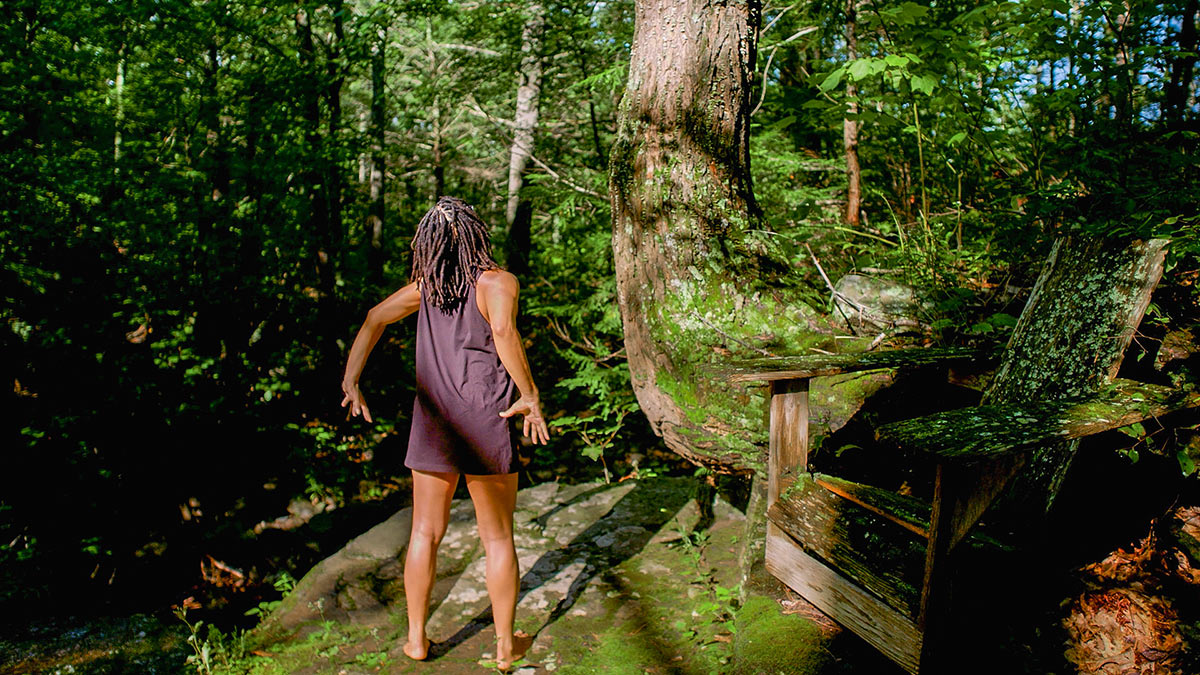
© Dancing Camera. (Click image for larger version)
Roberts talks about how he got into choreography to “solve all these riddles,” seeing each piece as a puzzle that he is both building, the master of, and a player at the same time. He chose his dancers, two women, two men because of their curiosity and openness. They dance in the woods as well as the studio. This is just a beginning, but with these superb dancers and the depth with which Roberts has imbued the two pieces now in the Ailey repertoire, one expects much. In another bubble that Roberts was in with a larger group of Ailey dancers, videoed on a terrace at the Ailey building on 9th Avenue and 55th Street, he surprises with wonderfully inventive movement to start a happy celebratory piece, which was featured for a week in the Ailey virtual season in December. Ailey director Robert Battle, with a fellow choreographer’s curiosity, asks if anything was improvised. Roberts says no, though what he had made on himself took on other nuances on other dancers.

© Dancing Camera. (Click image for larger version)
We’re back at Kaatsbaan for Isolation to Creation: Afrik, Ballet, Ballroom, Broadway, Club, House, and Vogue which mixes Ephrat Asherie Dance, Les Ballet Afrik with Omari Wiles, and, back at Petronio Residency, The Seven Deadly Sins group, Marc Happel, Joshua Bergasse, Sara Mearns, and Justin Vivian Bond. I wasn’t as convinced as producer and instigator Happel that this version of Weil’s work will seem just right. But it’s still at a quite preliminary stage. Back again at Kaatsbaan, in a transition to the next video, we see Sandoval and Richardson walking and talking and then Music from the Sole making music that The Missing Element dancers can groove to. I like the saxophone and beatbox rhythms that accompany the credits.
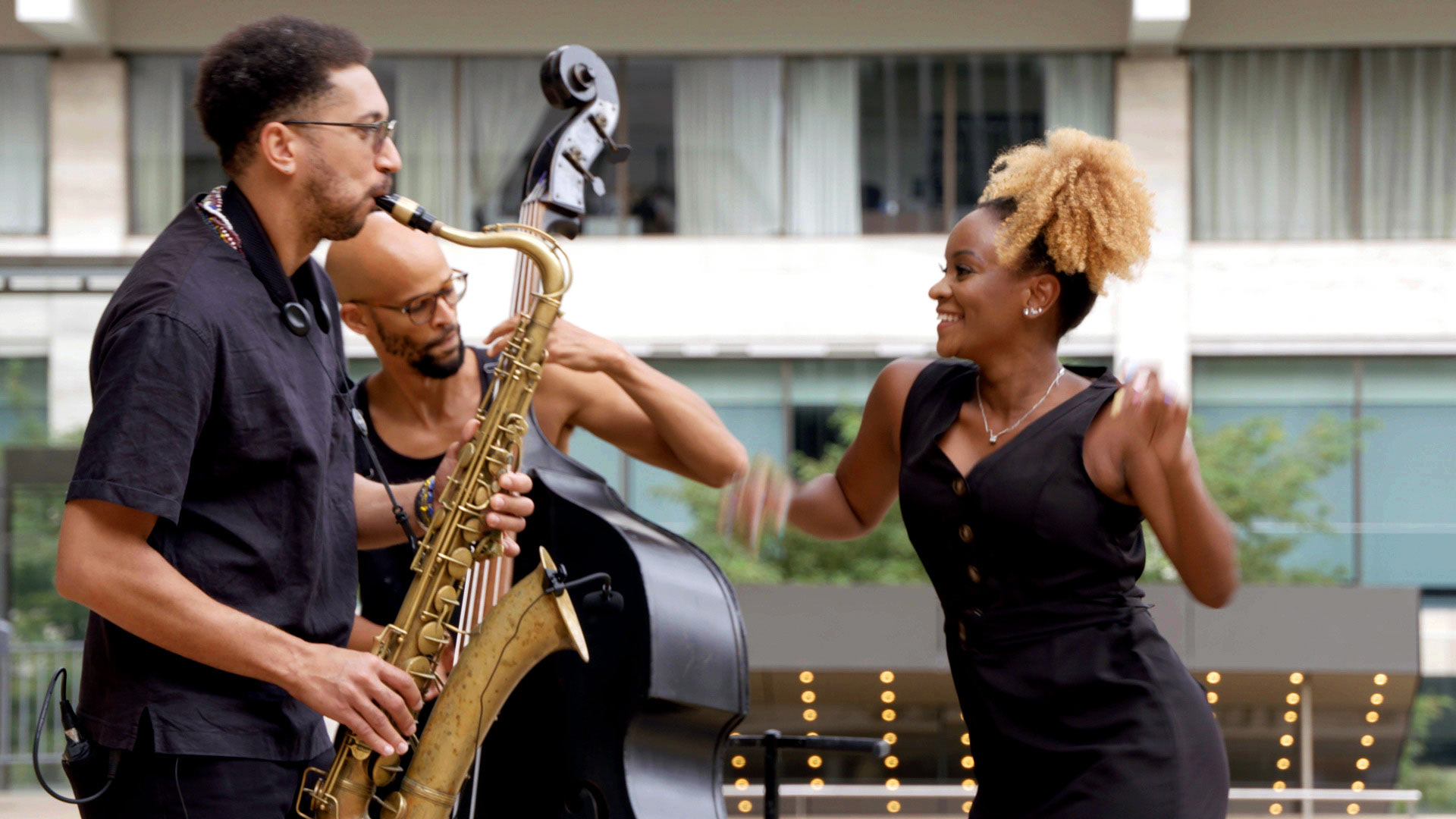
© Dancing Camera. (Click image for larger version)
As Part 3 shows, Ephrat Asherie Dance and Les Ballet Afrik have a lot in common. Both are diverse companies that integrate various African American vernacular forms. Both of their W&P projects, as Asherie and Wiles explain, combine these forms with expressions of LGBT invention at clubs and vogueing ballrooms. Wiles shows, for instance, how you can shift from the masculine into the feminine, a prelude to vogueing. Vogueing, like hiphop forms, involves a creative battle. We see Asherie’s and Wiles’ dancers rehearsing choreography, but just as valuable is seeing them dance inventively on their own in a house party or a break from rehearsal. And both directors stress that they use their dancers’ personal styles, whether elders like Burnett and Saunders, or regular company members, all important to the lively, rich creative mixes of both companies.
The last video, Isolation to Creation: Showtime concludes with glimpses of the setting up, rehearsing, and performances on the Kaatsbaan stage and at the Lincoln Center videoing. This is intercut with talking and informal moments, from cooking to having a good musical, dancing time. The glimpses of performances are enjoyable, though we see nothing complete. But it’s nice to see Stella Abrera, until recently a principal at American Ballet Theatre and now artistic director at Kaatsbaan, briefly dancing amid the bubblers. We see everybody again, including the two pods at Petronio, both in early stages of work not performed at Kaatsbaan nor at Lincoln Center where Part 4 moves to show us the making of those videos. Again the glimpses are fun, but Showtime, with all it crams in, is a bit diffuse.
The idea of building communities of artists through bubbles, restoring such community in pandemic times, certainly comes through in Isolation to Creation. For an enjoyable video of one particularly large and communal bubble, see Inside the Pillow Lab: Dorrance Dance, Michelle Dorrance’s tapdance company – and community – that took place at Jacob’s Pillow. Bubbles work, Isolation to Creation shows us, and a great many dance companies are making dance in them now. Works & Process isn’t alone, but it continues to be a very active and valued part of New York’s creative scene. We’re all looking forward to a possible return in the fall to live performance there – and everywhere.











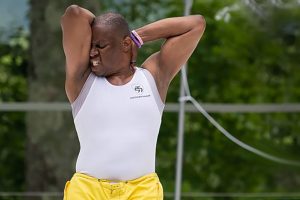


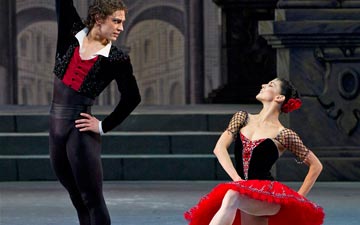
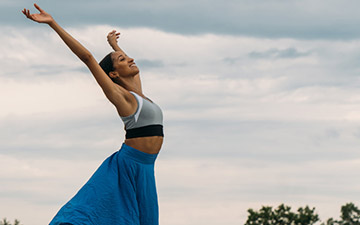
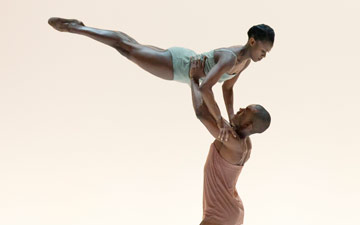
You must be logged in to post a comment.